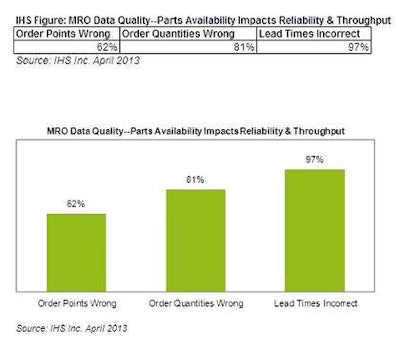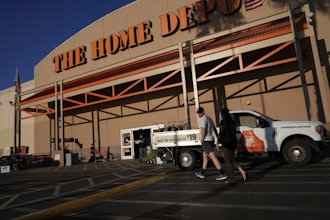
El Segundo, CA — Maintenance, repair and operations (MRO) groups at many companies are facing a major challenge: toxic MRO master catalogs stuffed with incomplete data on replacement parts, a problem that drives up costs and creates large-scale problems for multiple corporate divisions.
To combat this problem, companies must engage in a comprehensive effort to standardize and enrich MRO data, adopt a sustainable MRO data-governance model, and develop a strategy for MRO lifecycle management, according to John Ferguson, certified maintenance and reliability professional for the IHS Supply Chain service at information and analytics provider IHS.
Speaking last month via a live IHS webcast event entitled “Understanding the Cause & Effects of Toxic MRO Foundational Data,” Ferguson described the magnitude of the MRO-parts challenge and outlined possible solutions to the problem.
“Companies must recognize the importance of solid MRO foundational data, and they have to understand the correlation this has to other areas of their business,” Ferguson said. “Once they get the foundation right, other related goals or initiatives in operational excellence will be much easier. The lack of emphasis on MRO data quality results in inefficiency. Organizations waste an inordinate amount of time and resources in trying to make other pieces of the MRO lifecycle and maintenance and reliability work with master data that ranges from being poor quality to being downright ‘toxic.’”
Chain reaction
The problem of MRO inventories is massive, with stockpiles growing by 9 percent per year globally. Based on industry inventory data analysis, an estimated 55 percent of MRO inventories have not moved in the past three years—and 30 percent of MRO inventories that are currently in stock will never be used. Furthermore, 6 percent of MRO items make up 90 percent of the annual spend for companies in general.
However, the majority of reorder points as well as reorder quantities are incorrect, as are the lead times, presented in the attached figure. An estimated 62 percent of orders points are wrong—with 81 percent and 97 percent of order quantities and lead times being erroneous.
Crisis in a ball valve
During the event, Ferguson demonstrated the inefficiency of conflicting MRO data by showing the varying product descriptions of a single MRO part: a ball valve.
“A toxic catalog of replacement parts can affect other business processes,” Ferguson said. “A classic example—using actual data from a client—shows a ball valve and six different ways it was described within their MRO master catalog. The same part had multiple records with different descriptions, part numbers, and prices. This left the client with duplicate, inconsistent descriptions, affecting its capability to search and access information, as well as to get a foundation in place for getting to higher-level MRO process.”
These types of catalog inconsistencies prevent companies from locating required parts for scheduled and unplanned maintenance work. When parts cannot be located, companies purchase excess parts, causing inventories to balloon.
To prevent such negative ramifications on operations—and to leverage MRO data in support of corporate-wide initiatives that can improve efficiency—companies must put their MRO data into an accurate, consistent and structured format, free of duplicate parts.
Building the foundation
However, this process only serves as the basis of a set of other steps that companies must take to get engaged in MRO best practices. Following the process optimizing MRO data, companies must adopt a sustainable MRO data-governance model along with enabling technology that seamlessly integrates into their enterprise resource planning (ERP) and enterprise asset management (EAM) systems to dynamically synchronize their MRO data.
Next, companies should optimize MRO inventory. This can lead to more balanced inventory levels, and allow companies to conduct criticality analysis and make impact assessments.
Finally, companies need a systematic approach for classifying, managing and optimizing all aspects of their MRO value chain, including MRO materials master catalog data management, strategic sourcing, procurement, critical spares identification, balanced inventories, asset dispositioning strategies, and inventory and storeroom best practices.
“Once you get your foundation solidified, then you can get into optimizing your inventory and looking at spend analysis, such as what your maximum cost level should be and what your orders should be based on your usage history,” Ferguson said. “You can also get into more advanced MRO practices and use the foundation you’ve put in place to support broader corporate initiatives, like maintenance excellence, procurement excellence and other more efficient ways of doing business. “These actions all have positive aspects on the bottom line and shareholder value.
IHS (NYSE: IHS) is the leading source of information, insight and analytics in critical areas that shape today’s business landscape. Businesses and governments in more than 165 countries around the globe rely on the comprehensive content, expert independent analysis and flexible delivery methods of IHS to make high-impact decisions and develop strategies with speed and confidence. IHS has been in business since 1959 and became a publicly traded company on the New York Stock Exchange in 2005. Headquartered in Englewood, Colorado, USA, IHS is committed to sustainable, profitable growth and employs more than 6,000 people in 31 countries around the world.
IHS is a registered trademark of IHS Inc. All other company and product names may be trademarks of their respective owners. Copyright © 2013 IHS Inc. All rights reserved.






















